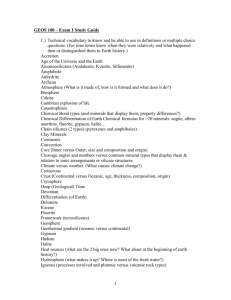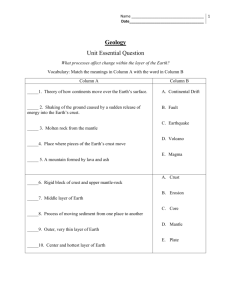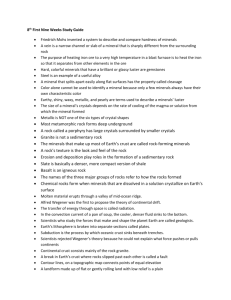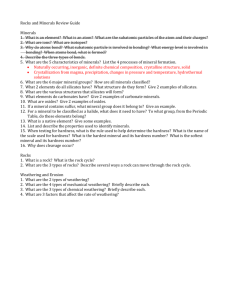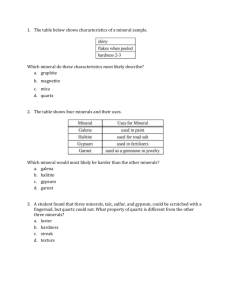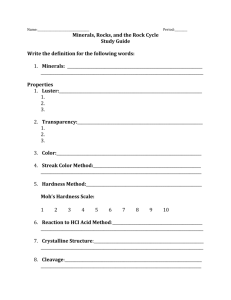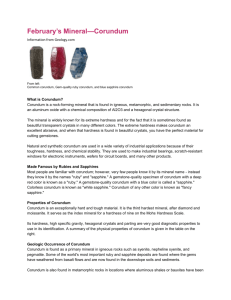GEOS 100 – Exam 1 Study Guide
advertisement
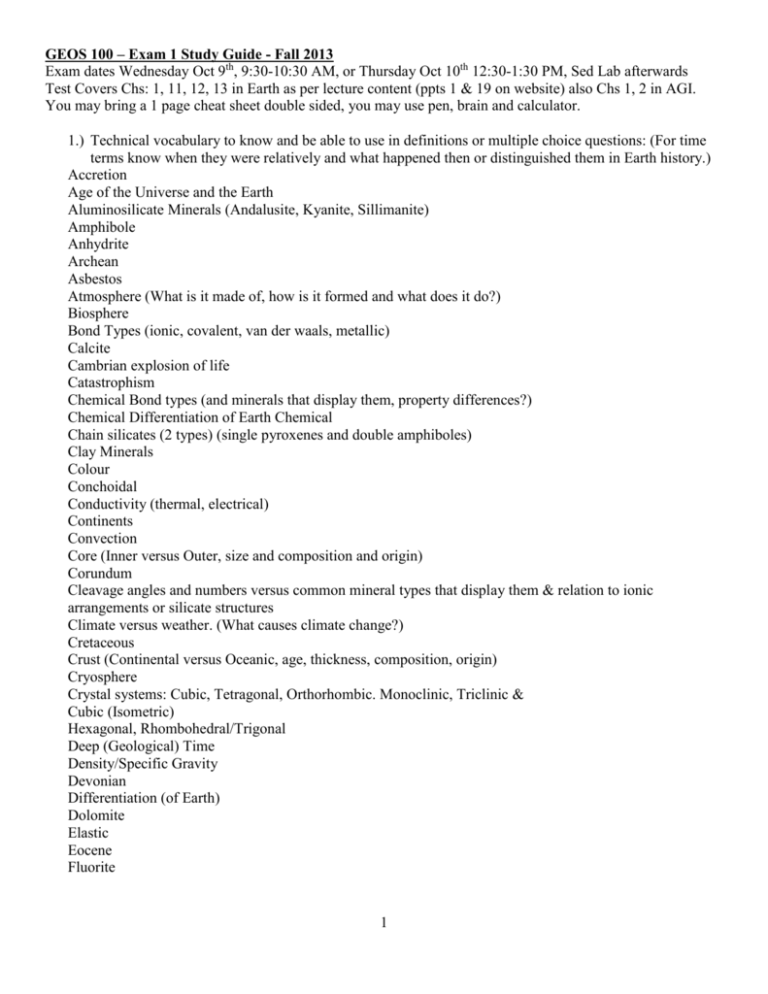
GEOS 100 – Exam 1 Study Guide - Fall 2013 Exam dates Wednesday Oct 9th, 9:30-10:30 AM, or Thursday Oct 10th 12:30-1:30 PM, Sed Lab afterwards Test Covers Chs: 1, 11, 12, 13 in Earth as per lecture content (ppts 1 & 19 on website) also Chs 1, 2 in AGI. You may bring a 1 page cheat sheet double sided, you may use pen, brain and calculator. 1.) Technical vocabulary to know and be able to use in definitions or multiple choice questions: (For time terms know when they were relatively and what happened then or distinguished them in Earth history.) Accretion Age of the Universe and the Earth Aluminosilicate Minerals (Andalusite, Kyanite, Sillimanite) Amphibole Anhydrite Archean Asbestos Atmosphere (What is it made of, how is it formed and what does it do?) Biosphere Bond Types (ionic, covalent, van der waals, metallic) Calcite Cambrian explosion of life Catastrophism Chemical Bond types (and minerals that display them, property differences?) Chemical Differentiation of Earth Chemical Chain silicates (2 types) (single pyroxenes and double amphiboles) Clay Minerals Colour Conchoidal Conductivity (thermal, electrical) Continents Convection Core (Inner versus Outer, size and composition and origin) Corundum Cleavage angles and numbers versus common mineral types that display them & relation to ionic arrangements or silicate structures Climate versus weather. (What causes climate change?) Cretaceous Crust (Continental versus Oceanic, age, thickness, composition, origin) Cryosphere Crystal systems: Cubic, Tetragonal, Orthorhombic. Monoclinic, Triclinic & Cubic (Isometric) Hexagonal, Rhombohedral/Trigonal Deep (Geological) Time Density/Specific Gravity Devonian Differentiation (of Earth) Dolomite Elastic Eocene Fluorite 1 Formulas for >20 minerals: albite-anorthite, apatite, augite, barite, calcite, chalcopyrite, corundum, diamond, fluorite, galena, graphite, gypsum, halite, hematite, kaolinite, kyanite, orthoclase, pyrite, magnetite, quartz, sphalerite, sylvite… Framework (tectosilicates) Fracture Geosphere Geothermal gradient (oceanic versus continental) Gypsum Hadean Halite Hardness Heat sources (what are the 2 big ones now? What about at the beginning of earth history?) Hematite Hexagonal Hornblende Hydrosphere (what makes it up? Where is most of the fresh water?) Igneous (processes involved and plutonic versus volcanic rock types) Isostasy Isotope (radioactive versus stable) Jurassic Lithosphere (crust plus brittle upper mantle, continental versus oceanic) Lustre Mantle (Upper, Lower, depths, compositions, origin) Magma (2 abundant types: basalt from peridotite and granite from lower crust e.g. gabbro or amphibolite) Magma evolution and processes: partial melting, fractionation, assimilation, mixing Magnetite Massive extinction Melting versus temperature Mesosphere Metamorphic (Dynamic, dynamothermal, Thermal and rock types: breccia and fault gouge, schist and gneiss, skarns and hornfels) Mid Ocean Ridges and Rifts (where, what happens, how long?) Mississippian Muscovite Micas (biotite, chlorite, muscovite, clays) Mineral Groups (by anion types: Oxides, Hydroxides, Halides, Sulfates, Sulfides, Carbonates, Phosphates and Silicates) know several of each type by name and a geological environment e.g. where would you classify and find: Chlorite, Limonite, Augite, Barite, Sphalerite, Hematite, Cassiterite, Sylvite, Dolomite, Beryl, Plagioclase – where does it occur, how abundant, how distinguished? Nebular Hypothesis Moh’s Hardness Scale: (Talc, Gypsum, Calcite, Fluorite, Apatite, Orthoclase, Quartz, Topaz, Corundum, Diamond) Monoclinic Ocean Basins Ordovician Orogen/Orogeny Orthoclase (K-spar) Orthorhombic Paleozoic, Phanerozoic and Precambrian: (Which came first? What do they mean?) 2 Paradigm, Theory, Hypothesis Pennsylvanian, Permian Plate Tectonics and motions (rates, directions, locations, plate margin processes) Physical Properties (Lustre, hardness, cleavage, fracture, habit, specific gravity, colour, conductivity) & what determines each? Polymorphs (What are 2 for Carbon? For Calcium Carbonate, Aluminosilicates? Etc.) Precambrian (Hadean, Archean, Proterozoic, Ediacaran) Pyroxene Radioactivity Radius of Earth Rhombohedral/Trigonal Rifts and Mid ocean ridges Rock Cycle Scientific Method: observation, hypothesis, theory, test, reiterate… Sedimentary (processes involved: clastic and bio-chemical and rock types) Seismicity/seismology (Why does earth have this and what can it tell us?) Sheet silicates (phyllosilicates) Streak Subduction Zones (where, what happens, how long) Tectonic Boundary (what are the 3 types and what happens there?) Tectosilicates: Quartz, feldspars, zeolites. What do they all have in common? Tetragonal Transform faults, Deep sea trenches and subduction zones Triclinic Uniformitarianism Wilson Cycle (what is it and how long does it last?) 2.) Study guide questions from the back of each chapter: facts, theories, minerals, rocks, relating processes: What is memorable about Mt. Logan? What is the current world population and how does this relate to natural resource use? Is there any causal relationship between earthquakes and landslides? Is there any causal relationship between earthquakes and volcanoes? What are gradual versus episodic geological processes and give examples? What are geological hazards and what do they have to do with human activity versus natural processes? What is the relationship between geological time, processes and long term changes like: uplift, erosion, weathering, transport, sedimentation, melting, crystallization, compaction, cementation, landscape evolution, mountain building, subsidence etc? Who were Ussher and Hutton and what “contributions did they make? What are the layers of the Earth, their make up, thicknesses and origin? What is the difference between a mineral and a rock? 3 Where do mountain belts form? What processes control the heights of mountain belts or the depths of ocean basins? Where does the rock cycle occur at the fastest rate? What kinds of rocks are not made from minerals? What distinguishes an ore from a non-economic mineral? What rocks exhibit volcanic textures and which have plutonic ones? How and where are diamonds formed? What kinds of minerals are found in placer deposits? What are the most abundant mineral types in each of earth’s major layers? What are the dominant rock types in ocean crust, continental crust and mantle? How does the Earth come to have internal heat and convection? What and where is the low velocity zone? Why does the temperature rise with progressive depth inside the Earth? What are the 2 dominant types and locations of partial melting? What are 2 fundamentally different kinds of sediments or sedimentary rocks? When and where does metamorphism occur? What characteristics distinguish the precious gems from other minerals? Do all geological processes operate at the same rates and in all locations throughout geological time; why or why not? Are mineral deposits uniformly distributed; why or why not? What minerals make up Moh’s hardness scale? Be able to explain the chemical or structural basis for mineral properties such as hardness, cleavage, luster, specific gravity etc. What are polymorphs and give examples from abundant minerals. What kinds of changes can transform one rock type into another? Discuss this for 2 rocks and explain how they are related by the rock cycle. Where on or in the Earth would this transformation occur? 4 Exam Format: </=10-15 matching terms and definitions e.g. H 1. High pressure polymorph of carbon H. Diamond 20-60 Multiple choice (pick best answer and write letter of that answer in blank at edge of test form. E.g. ____ 22. Planet with common water found in all 3 phases: solid, liquid and gas. a. Mercury b. Pluto c. Earth d. Venus 4-6 Essay-discussion-labelled drawings e.g. (10 – 25 points) Draw a cross section of Earth labeling its internal layers. Indicate at what depth the boundaries occur. Show any zones of liquid or partial melting and indicate where internal convection occurs especially relative to layers and lithospheric plate edges. Label and describe the origin of Earth’s magnetic field relative to a globe or cross section of the planet. Explain internal heat in the planet and discuss how it relates to earthquakes, volcanoes, hotsprings and magnetism. How do we know how fast and in what directions, the plates move? Discuss >3 ways we can measure or calibrate the rates of plate motions describing what specifically is measured, over what period of time or span of distance. Describe the initial formation of the Solar system and what observations support this theory. Describe the initial differentiation of the Earth and describe the resulting internal structures. Label and name the common crystal forms of rock forming minerals or match minerals to diagrams of structures provided. 5
